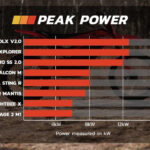Riding a bike, whether it’s tackling challenging trails or enjoying a leisurely road ride, is a fantastic way to stay active and explore the outdoors. However, staying properly hydrated, especially during warmer months or intense workouts, is crucial for performance and enjoyment. There’s nothing quite as disappointing as reaching for your water bottle mid-ride, hoping for a refreshing gulp of cold water, only to be met with a lukewarm disappointment. For years, cyclists have grappled with the challenge of keeping their drinks cool on the bike, often relying on standard insulated plastic bottles that promise much but deliver only fleeting coolness.
 Riding a bike in hot weather
Riding a bike in hot weather
These typical insulated plastic bottles, with their thin layer of foam sandwiched between plastic walls, offer a marginal improvement over standard bottles. They slow down the warming process slightly, but against the combined forces of direct sunlight, high temperatures, and wind generated by cycling speed, they quickly succumb. Ice melts rapidly, and what was once a refreshing chill turns into tepid water, leaving you wanting more just when you need it most.
But what if there was a better way? Enter the realm of vacuum-insulated metal bike bottles, pioneered by brands like Bivo with their Trio bottle. These bottles adopt technology similar to everyday water bottles from brands like Yeti and Hydro Flask, utilizing double-wall vacuum insulation. This superior insulation method promises to significantly outperform traditional plastic bottles in keeping your drinks cold for longer. The question then becomes: does this technology translate effectively to the demands of cycling, and does a metal bottle offer a practical alternative to the familiar plastic?
The Cold Truth: Bivo Trio vs. Insulated Plastic Bottles
To put the Bivo Trio to the test, a direct comparison was conducted against a standard insulated plastic water bottle. Both bottles, with a similar 21-ounce capacity, were filled with an equal amount of ice and topped with water. They were then placed in direct sunlight on an 80-degree day. The results after four hours were striking. The plastic bottle contained no ice whatsoever, and the water was nearing unpleasantly warm. In stark contrast, the Bivo Trio still held a significant amount of ice, and the water remained refreshingly ice-cold.
 Bivo Trio water bottle test
Bivo Trio water bottle test
This initial test highlighted the superior insulation of the Bivo Trio. To simulate real-world cycling conditions, both bottles were taken on an hour-long bike ride in 85-degree temperatures. The outcome mirrored the static test. By the end of the ride, the water in the plastic bottle was noticeably warming, while the Bivo bottle remained packed with ice. The manufacturer claims the Bivo Trio can keep drinks cold for up to 12 hours, suggesting it would easily handle even longer rides in hot conditions.
Beyond Cold: Advantages of the Bivo Trio
Beyond its impressive cooling performance, the Bivo Trio offers other advantages. The high-flow nozzle design allows for a greater volume of water to be dispensed quickly, which can be beneficial during intense cycling when quick hydration is needed. Many users also report a cleaner taste with metal bottles compared to plastic, as metal is less likely to impart flavors into the water, enhancing the drinking experience.
 Bivo Trio nozzle design
Bivo Trio nozzle design
Weighing the Trade-offs: Considerations for Metal Bike Bottles
Despite its clear advantages in cooling, the Bivo Trio and metal bike bottles in general do come with certain trade-offs compared to plastic bottles. One common concern is bottle cage compatibility. While Bivo states they designed the Trio to fit most standard bike cages, the rigidity of metal makes insertion and removal less flexible than with a pliable plastic bottle. This can be a minor inconvenience or a more significant issue depending on your cage tightness and riding style, especially when needing to grab a drink quickly on rough terrain.
Price is another factor. The Bivo Trio, at a higher price point, represents a more significant investment than insulated plastic bottles like the CamelBak Podium Chill, which is considerably more affordable. The potential for loss or damage, common occurrences in cycling, becomes a greater concern with a more expensive bottle.
Finally, weight is a consideration, particularly for cyclists focused on minimizing every gram. Metal bottles are generally heavier than plastic counterparts. While Bivo claims to use less material to reduce weight, the Bivo Trio is still heavier than a Podium Chill. For competitive cyclists or those sensitive to weight, this difference might be noticeable.
Finding Your Ideal Hydration Strategy
Ultimately, the “Best Water Bottle For Bike Riding” isn’t a one-size-fits-all answer. For cyclists prioritizing maximum cold retention for long rides in hot weather, the Bivo Trio or similar vacuum-insulated metal bottles are compelling options. However, for shorter rides, budget-conscious riders, or those highly sensitive to weight and bottle cage ease-of-use, insulated plastic bottles remain viable choices.
A balanced approach might be the most practical solution for many. Utilizing a metal bottle for longer, hotter rides and plastic bottles for shorter, cooler outings allows you to leverage the strengths of each type. Some cyclists even adopt a mixed strategy within a single ride, starting with a plastic bottle and switching to a metal bottle later to ensure a supply of cold water throughout.
 Cyclist reaching for water bottle
Cyclist reaching for water bottle
Choosing the right water bottle is a small but significant part of enjoying your bike rides. By understanding the pros and cons of different types, you can make an informed decision that keeps you hydrated, comfortable, and performing at your best, no matter the conditions. Whether you opt for the superior cooling of a metal bottle or the practicality of plastic, prioritizing hydration is key to every successful bike adventure.

